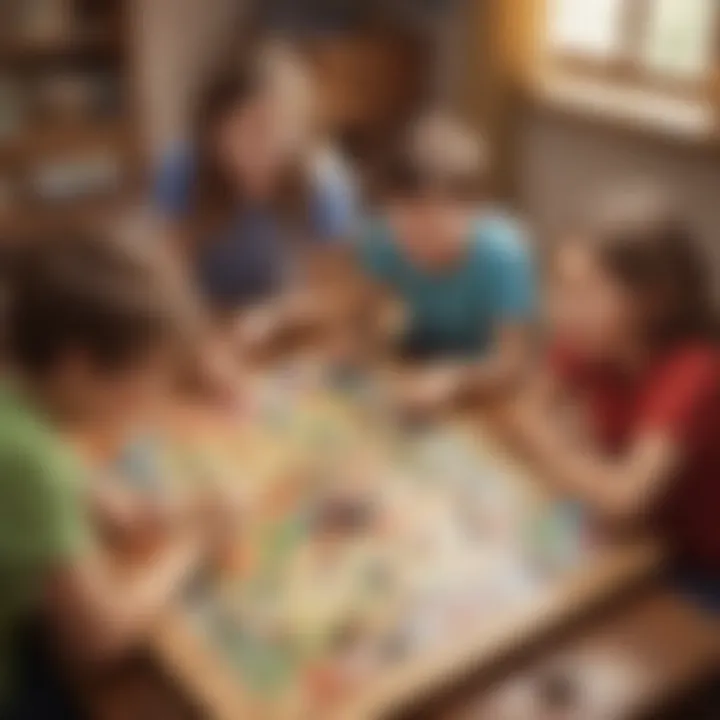Exploring Activities Board Games: Learning and Fun


Intro
Board games have a long history and continue to play a significant role in childhood development. The rise of activities board games shows their potential to enhance learning, social skills, and cognitive abilities in elementary school children. This article explores various aspects of these games, shedding light on their value in education and socialization. Parents and educators are increasingly recognizing the educational benefits of engaging children with structured, enjoyable play through these games.
Creative Activities
Creative activities are crucial for stimulating a child's imagination and fostering skills that will be beneficial throughout their lives. Activities board games often incorporate elements that inspire children to think outside the box, as they actively participate in the game.
Craft Ideas
Crafting can complement board games by engaging children in hands-on creativity. Here are some simple craft ideas:
- Board Game Customization: Kids can create their own game pieces using clay, paper, or any materials available at home.
- Themed Game Boards: Children can draw and decorate game boards based on their favorite stories or characters, boosting their attachment and engagement with the game.
Step-by-Step Guides
To effectively implement these craft ideas, detailed instructions are necessary:
- Choose a game to customize.
- Select materials for creating game pieces or boards.
- Encourage imaginative designs by allowing children to express their vision through their creations.
- Play the modified game to appreciate the newly created elements.
Completing such activities helps reinforce the core concepts of the game while sharpening fine motor skills.
Educational Value
Engaging in these creative activities promotes various educational outcomes. Children practice planning, critical thinking, and decision-making. Additionally, crafting fosters fine motor skills and spatial awareness. When board games are infused with these activities, they transform into multifaceted learning tools.
Fun Quizzes
Quizzes are an interactive way to engage young minds and reinforce knowledge. These quizzes can be integrated with activities board games to deepen understanding of the subject matter.
Quiz Topics
The topics covered in quizzes can vary widely, allowing for adaptations to suit the themes of the board games. Common subjects include:
- Mathematics and logic.
- History and geography.
- Science fundamentals.
Question Types
To keep children engaged, quizzes should utilize a variety of question types:
- Multiple Choice Questions: These are simple and easy to understand.
- True or False Statements: Great for quickly assessing basic knowledge.
- Fill-in-the-Blank: Encourages recall and deeper learning.
Knowledge Reinforcement
Quizzes help reinforce the knowledge gained from activities board games. As children recall facts or process information, their retention improves. They can build confidence in subject comprehension, making learning enjoyable.
Fact-Based Articles
Fact-based articles can enhance children's understanding of the subjects they explore through board games. These resources serve as valuable supplements to the fun and learning experienced in gameplay.
Topics
Articles on a range of topics can engage children. Examples might include:
- Animal behavior and habitats.
- Simple physics concepts.
- Historical events tailored to age-appropriate levels.
Engaging Content
The information presented in these articles should be clear and straightforward, ensuring easy understanding. Including visuals, such as illustrations or charts, can enhance comprehension.
Preface to Activities Board Games
The realm of activities board games is rich in educational value and engagement potential. Understanding their significance requires a closer look at what they offer beyond mere entertainment. These games provide avenues for cognitive growth, social interaction, and creative expression, primarily targeted at elementary school children.
Activities board games foster critical skills that are essential in childhood development. They serve not just as a distraction but as platforms for learning key concepts and enhancing abilities such as problem-solving and teamwork. Moreover, they create a nurturing environment where children can develop emotionally, cultivating resilience and empathy through interactive and cooperative play.
Incorporating these games into daily routines helps establish a balance between leisure and education. This balance allows children to perceive learning as enjoyable rather than a chore. Parents and caregivers increasingly recognize the role of board games as tools that promote family bonding and provide opportunities for dialogue, making them an integral part of modern childhood.
Definition and Purpose
Activities board games can be defined as structured forms of play that utilize boards, pieces, and rules to guide gameplay. Their primary purpose extends beyond fun; they are designed to stimulate learning and development in various domains. Educational objectives often include enhancing intellectual skills and enriching social experiences.
Ideally suited for children aged five to twelve, these games are versatile. They can cover various subjects, from mathematics to language arts, making them a valuable educational resource. The purposeful engagement that these games promote is vital. By stimulating curiosity and encouraging interaction, board games foster a love of learning.
Historical Context
The history of board games is lengthy and diverse, with ancient civilizations using them as tools for both entertainment and social interaction. Evidence suggests that games like Senet and Go have been played for thousands of years, emphasizing their long-standing presence in human culture. Over time, their functions have evolved.
In the 20th century, board games began to be viewed through an educational lens. Psychologists and educators recognized their potential in shaping social skills and cognitive abilities. As the educational model shifted towards experiential learning, board games acquired popularity in schools and homes alike. This historical context helps in understanding the present-day significance of activities board games and their enduring appeal to children and adults.
Types of Activities Board Games


The variety of activities board games influences their effectiveness in educational settings and social interactions. Each type serves a unique purpose and addresses different learning aspects for elementary school children. Understanding these categories helps parents, caregivers, and educators select the right games that align with specific developmental goals.
Educational Games
Educational games focus on teaching fundamental concepts across various subjects, such as math, science, and language arts. These games are designed to promote engagement while ensuring that learning remains enjoyable.
Key Features of Educational Games:
- Interactive Learning: Children interact with game elements that reinforce the subject matter.
- Critical Thinking: Many educational games require players to solve problems, fostering analytical skills.
- Skill Reinforcement: Repetitive gameplay helps solidify knowledge and improve retention of educational content.
When children play educational games, they learn without feeling pressured. This is crucial to avoid discouragement that often comes with traditional learning methods.
Strategy Games
Strategy games engage players in planning and decision-making. These games challenge children to think ahead and develop tactics to achieve goals. They foster skills like patience and foresight.
Benefits of Strategy Games:
- Enhanced Problem-Solving: Players navigate obstacles, improving their ability to find creative solutions.
- Resource Management: Many strategy games require players to allocate resources wisely, teaching essential budgeting skills.
- Long-term Planning: Players must anticipate opponents' moves, enhancing strategic thinking.
Children learn that every decision has consequences. This insight is vital for their overall growth.
Cooperative Games
Cooperative games promote teamwork by requiring players to work together to achieve common goals. This type of game builds community and teaches essential social skills.
Characteristics of Cooperative Games:
- Collective Goals: Players must collaborate to win, fostering a sense of belonging.
- Conflict Resolution: Working together encourages communication and negotiation.
- Shared Success: Celebrating victories as a team reinforces shared experiences.
Through these games, children understand the importance of cooperation. Skills learned in cooperative games translate into real-life relationships.
Creative Storytelling Games
Creative storytelling games emphasize imagination and narrative skills. These games allow players to construct stories and engage in role-playing. They cultivate creativity and expressive skills.
Highlights of Creative Storytelling Games:
- Imaginative Play: Players can explore different scenarios, fostering creativity.
- Communication Skills: Articulating thoughts and ideas is essential in storytelling, enhancing verbal communication.
- Empathy Development: Role-playing characters allows children to view situations from different perspectives.
These games not only entertain but also nurture essential skills. An appreciation for stories may inspire a lifelong love for reading and creativity.
Benefits of Activities Board Games
Activities board games are more than just leisure tools; they offer significant benefits that support children’s growth and learning. From cognitive enhancement to the development of social skills, these games play a crucial role in shaping well-rounded individuals. This section elaborates on the diverse advantages provided by activities board games, each of which contributes to elementary school children’s holistic development.
Cognitive Development
Cognitive development is a fundamental aspect of childhood learning. Engaging with activities board games helps children improve their mental capabilities.
Problem-Solving Skills
Problem-solving skills are essential for navigating daily challenges. Children learn to analyze situations and seek effective solutions through gameplay. This aspect of board games encourages critical thinking and adaptability.
One key characteristic is that problem-solving involves pattern recognition and logic. These skills become useful in academic settings and beyond. Games that require strategic planning, like "Robo Rally," illustrate this well. They challenge players to anticipate opponents' moves and devise strategies accordingly.
A unique feature is the immediate feedback players receive from their choices. Children learn what works and what doesn't after each round, fostering a mindset of trial and error. This iterative learning process can be advantageous as it builds resilience in facing failures.
Critical Thinking
Critical thinking skills stem from evaluating information and making reasoned decisions. Board games provide scenarios where children must consider various factors before drawing conclusions.
Critical thinking encourages children to question assumptions, analyze evidence, and build sound arguments. Games designed for deeper analysis, like "Settlers of Catan," offer rich learning experiences. Players must weigh resource management against competitor strategies, cultivating analytical abilities.
Its unique elements, including strategic choices and logical reasoning, contribute to critical thinking development. In this sense, activities board games are a popular choice within educational contexts due to their interactive nature.
Social Skills Enhancement
Social skills are integrated throughout activities board games. They promote interactions that help children learn to communicate effectively and engage with their peers.
Teamwork
Teamwork in board games fosters collaboration among players. Many games necessitate group effort to achieve shared goals. Children learn to rely on team members while developing their roles within a group.
The key characteristic here is the coordination of diverse skill sets. Each player brings a unique ability to the table, aiming to complete challenges that may be overwhelming alone.
A unique feature of teamwork-focused games, such as "Pandemic," is the open communication required for strategy formation. This aspect not only strengthens player bonds but also enhances problem-solving capabilities in collaborative settings.
Communication
Effective communication is vital, especially in multiplayer settings. Board games create opportunities for children to express thoughts clearly while listening to others.


One key characteristic of communication in this context is that it encourages constructive dialogue. During gameplay, children practice articulating ideas, clarifying misunderstandings, and negotiating outcomes.
For instance, games like "Dixit" allow players to interpret images creatively. This interpretation fosters ability to convey messages through storytelling, promoting development of expressive skills. Communication serves as a bridge for emotional exchange between players.
Emotional Intelligence
Emotional intelligence encompasses the awareness and ability to manage emotions. Activities board games facilitate the cultivation of this essential skill.
Empathy
Empathy is vital for social interaction and understanding others' viewpoints. In board games, players frequently encounter scenarios that require them to consider the feelings of others.
The key characteristic of empathy here is the ability to put oneself in another’s position. Games that allow role-play elements, like "Coup," encourage children to appreciate diverse perspectives. This enriches their experience and enhances interpersonal competence.
A notable feature is that empathy promotes conflict resolution. When children feel included and valued, they are more likely to engage positively with peers. This benefit extends far beyond the game table.
Resilience
Resilience allows children to bounce back from setbacks. Activities board games present challenges that can lead to failure, prompting players to adapt and try again.
The key characteristic of resilience is the ability to persist despite difficulties. Children become accustomed to handling defeat through gameplay, which is important for emotional growth.
A unique feature of resilience-building games, such as "Jenga," lies in their unpredictability. As structures fall, players learn to manage frustration and develop coping strategies. This emotional fortitude is fundamental in their development.
Motor Skills Development
Activities board games also enhance fine motor skills. The act of manipulating game pieces fosters dexterity and hand-eye coordination.
Playing games that require movement of tokens, cards, or dice, such as "Sorry!" or "Snakes and Ladders," helps children strengthen their motor abilities. The physical engagement involved in these games reinforces skills that are essential for daily activities.
In summary, activities board games offer crucial benefits that span cognitive, social, and emotional dimensions. They not only serve as sources of entertainment but also as profound educational tools that prepare children for future challenges. With thoughtful implementation, these games can transform learning landscapes and contribute to holistic childhood development.
Design Considerations for Activities Board Games
Design considerations play a vital role in the development of activities board games. They ensure that the games are effective, engaging, and suitable for the intended audience, particularly elementary school children. When creating a board game, designers must think about several factors that can influence gameplay and educational outcomes. The right design can elevate a simple game into a powerful tool for learning.
Age Appropriateness
Age appropriateness is essential when designing activities board games. Selecting themes, language, and game mechanics that resonate with children aged five to twelve is critical. Young players have different cognitive abilities and interests compared to teenagers or adults. A game meant for younger children should be simpler, focusing on basic concepts and colorful visuals that capture their attention. For example, games that include elements like counting, matching, or simple strategy can help engage children effectively.
In contrast, a game created for older kids may incorporate challenges that stimulate critical thinking and problem-solving skills. Ensuring age appropriateness can lead to enhanced engagement and better learning outcomes.
Difficulty Levels
Another important factor is the game’s difficulty level. Activities board games should offer a range of challenges that cater to different skill levels. For children who are just starting, games should be straightforward and gradually increase in complexity. This approach prevents frustration, allowing kids to learn and enjoy the game simultaneously.
A balanced difficulty level encourages children to persist through challenges. It can also motivate them to improve their skills. Designers may include multiple levels or alternative rules to adjust the complexity as needed. The goal is to keep players motivated without overwhelming them.
Inclusivity and Accessibility
Inclusivity and accessibility are also crucial designs considerations. Board games should be developed to include all children, regardless of their abilities. This can mean creating games that have clear instructions, visual aids, and adaptive components for children with disabilities. Games that promote teamwork and group dynamics can be exceptionally effective, as they foster a sense of belonging among players.
Moreover, incorporating diverse themes that reflect various cultures and experiences can enhance the players' connections to the game. Children can learn about and celebrate diversity while playing, making it a valuable social learning experience.
An engaging activities board game not only entertains but also enriches children’s educational journeys through thoughtful design.
In summary, considering age appropriateness, difficulty levels, and inclusivity ensures that activities board games are not just products but essential educational tools. Thoughtful design can lead to transformative experiences for children, promoting learning and social interaction.
Implementing Board Games in Educational Settings
The implementation of board games in educational contexts serves multiple valuable purposes. They bridge the gap between entertainment and learning, allowing for an engaging experience that fosters various skills. By bringing games into classrooms and after-school programs, educators can leverage the innate desire for play found in elementary school children. This approach makes learning enjoyable while simultaneously developing critical cognitive, social, and emotional skills.
Integration into Curriculum
Board games can be integrated into the curriculum effectively, offering structured learning opportunities in a playful context. This integration can take two distinct forms:
Subject-Specific Applications
Incorporating board games specific to subjects like math, science, and language arts can significantly enhance learning outcomes. For instance, a math game may focus on addition or multiplication, using game mechanics to motivate students to practice these skills. The key characteristic of subject-specific applications is their focused approach to particular learning objectives. This focus makes them a beneficial and targeted choice for educators aiming to improve student understanding of specific content areas.
A unique feature of these applications is their immediate feedback mechanism, which can boost students’ confidence and comprehension. However, the challenge lies in ensuring that each game aligns closely with curriculum standards. Misalignment can make a game less effective as a learning tool because it may not address essential skills required by educational standards.
Cross-Curricular Connections
Cross-curricular connections through board games offer a holistic approach to education. These types of games facilitate learning across different subject areas, promoting interrelated thinking. For example, a board game may incorporate history and math, introducing concepts from both subjects in a single game session. The key characteristic of cross-curricular connections is their ability to create a more engaging and meaningful learning experience.
The unique feature of these connections is their potential to mimic real-life scenarios where multiple disciplines intersect. This can be advantageous for developing well-rounded students who see the relevance of what they are learning. However, it can be challenging to maintain focus on each individual subject while successfully integrating them into a single gameplay experience.
After-School Programs
After-school programs represent another significant opportunity for implementing board games. These environments often focus on reinforcing concepts learned during the school day while providing a social setting for students. Board games in after-school programs can effectively engage children, encouraging them to explore subject matter further in a relaxed atmosphere. Participants can spend time developing problem-solving skills and working collaboratively with their peers while having fun.


Moreover, integrating board games into these programs can provide a structured yet flexible approach to learning. The social interactions fostered in these settings can enhance students' teamwork and communication abilities, which are essential aspects of learning beyond academic content. In summary, the implementation of board games in educational settings creates enriching experiences, blending fun and learning in valuable ways.
Case Studies on Activities Board Games
Case studies provide real-world examples that highlight the effectiveness of activities board games in educational settings. Examining these instances deepens our understanding of how board games can enhance cognitive development, social skills, and overall learning experiences in elementary school children. They showcase practical applications, allowing other educators and parents to visualize the potential benefits of integrating games into learning environments.
Success Stories from Schools
Numerous schools have implemented activities board games with remarkable results. For example, a school in Illinois introduced cooperative games, promoting teamwork among students. Teachers noted significant improvements in students' engagement and collaboration. The act of working together to achieve a common goal helped children develop not only friendships but effective communication skills.
Another case is observed in a New York City school where educational games became part of the math curriculum. By using board games focused on mathematical concepts, students found learning to be enjoyable. The interactive aspect of these games led to greater retention of mathematical principles. As a result, test scores improved notably over the year, stressing the way games can effectively reinforce academic content.
"These games changed the way our students approach challenges. They now see problems as opportunities for teamwork." - An Illinois teacher's reflection on the impact of cooperative games.
Insights from Educators
Educators across various institutions have shared insights about the role of activities board games in learning. Many express a strong belief in the power of play as a pedagogical tool. For example, teachers emphasize that board games can provide a safe environment for students to make mistakes and learn from them. They support the development of emotional intelligence, such as empathy and resilience.
Moreover, educators have noted that board games allow for differentiation in learning. Students with varied skill levels can participate and contribute based on their strengths. This inclusivity fosters an environment where every child feels valued.
Incorporating activities board games into teaching methods not only supports curriculum objectives but also nurtures a love for learning among children. Teachers now often consider game-based learning as essential, helping them refine their approach to education.
These case studies highlight how activities board games bring educational concepts to life, ensuring that learning remains a dynamic process.
Challenges in Using Board Games
When integrating activities board games into education and social settings, various challenges may arise. Each obstacle can significantly impact the effectiveness of these games in fostering learning and interaction among elementary school children. Recognizing these challenges is essential to developing strategies that ensure board games are used optimally.
Resource Limitations
Resource limitations can hinder the implementation of activities board games in schools and homes. Many educational institutions operate under tight budgets, making it difficult to acquire a comprehensive collection of diverse games. This can create a situation where only a few types of games are available, limiting the potential for students to engage with different learning experiences. Furthermore, a lack of space may restrict game setup and play, making it hard to facilitate group activities.
Additionally, educators may need assistance to understand how to effectively incorporate these games into their lesson plans. Without proper training, teachers might misuse the games or fail to leverage their full potential as educational tools. Hence, investing in resources, training, and a variety of games is critical to overcoming these limitations.
Game Design Constraints
Game design constraints also present significant challenges. Developing board games that are appropriate for different age groups and skill levels can be complex. A game must be engaging enough to captivate children’s attention but not so complicated that it frustrates them. Balancing this can require extensive research and feedback to ensure the game meets educational objectives while remaining fun.
Moreover, there are challenges related to inclusivity. Designers must consider diverse learners, including those with special needs or learning disabilities. Creating games that accommodate various learning styles requires a thoughtful approach to design, keeping in mind the accessibility features that can make a game enjoyable for all.
Effective game design must consider resources available, the target audience, and the educational goals to ensure maximal engagement and learning potential.
This careful consideration in game development plays a crucial role in successfully integrating activities board games into educational environments. By addressing these design constraints, developers can create better tools that not only entertain but also promote valuable learning experiences.
Future Trends in Activities Board Games
Exploring future trends in activities board games reveals how they evolve to keep pace with changing educational needs and technological advancements. Understanding these trends helps educators, parents, and game designers recognize the potential of board games as learning tools. The importance lies in how these trends enhance engagement and foster deeper learning experiences for children.
Technological Advancements
Digital Board Games
Digital board games are transforming the landscape of traditional games. These games offer interactive experiences that can engage children in new ways. One of the most significant characteristics of digital board games is their accessibility. Many can be played on various devices, including tablets and smartphones, allowing for both solo play and multiplayer options. This flexibility makes digital board games a popular choice among parents and educators.
A unique feature of digital board games is the ability to update content easily. Game designers can introduce new challenges or themes, keeping the experience fresh and relevant. While the advantages of digital board games include convenience and continuous engagement, there are some disadvantages. For example, increased screen time is a concern among parents. A balanced approach between digital and physical games may prove beneficial.
Augmented Reality Integration
Augmented reality (AR) integration is another exciting trend in activities board games. This technology overlays digital elements onto the real world, providing an immersive experience that appeals to children's imaginations. The key characteristic of AR integration is its interactivity. Children can literally see their physical game board come to life with animated characters or interactive challenges. Such engagement can enhance learning outcomes.
AR’s unique feature is the ability to create a visual and sensory experience. This not only makes games more enjoyable but also aids in understanding complex ideas by providing contextual visuals. However, the potential downsides may include the need for specific devices or applications to use AR, which can be a barrier to access for some children.
Sustainability in Game Design
Sustainability in game design is becoming increasingly vital. As awareness of environmental issues grows, educators and parents are looking for games that are not only fun but also environmentally friendly. This trend emphasizes the use of sustainable materials in the production of board games, reducing their carbon footprint. Moreover, many game designers are now focusing on creating games that promote awareness of environmental challenges, making learning both interactive and impactful.
Additionally, incorporating sustainability concepts in activities board games can encourage children to think critically about their environment. By understanding how their choices in games reflect real-world issues, children may become more conscious individuals. This trend emphasizes the growing recognition of the need for education surrounding sustainability, ensuring that future generations are better equipped to tackle global challenges.
Finale
Understanding the significance of activities board games is essential to grasp their benefits for children. This article has elaborated on various aspects, highlighting the educational potential these games possess. They simulate real-life situations, helping children practice critical skills in a controlled environment. Key insights include their ability to foster cognitive development, enhance social skills, and improve emotional intelligence.
Recap of Key Insights
Activities board games contribute positively to children’s growth in various ways:
- Cognitive Development: Through problem-solving and critical thinking, children strengthen their mental abilities.
- Social Skills: They learn teamwork and communication, as games often require collaboration and interaction with peers.
- Emotional Growth: Engaging in these games helps build empathy and resilience, crucial traits in today’s world.
These insights underscore the multifaceted advantages of integrating board games into both educational settings and home environments.
Call to Action for Educators
Educators are encouraged to incorporate activities board games into their curricula and extra-curricular programs. Doing so can create dynamic learning experiences that hold children's attention and actively engage them.
- Consider selecting games that align with specific learning objectives.
- Encourage group activities to build social interactions among students.
- Monitor and assess the skills developed through gameplay, adjusting strategies as necessary.
Adopting these practices can enrich the learning environment, making education a more comprehensive experience. For further insight on this topic, educational resources and communities such as Wikipedia, Britannica, and discussion platforms like Reddit can offer additional support and ideas.







